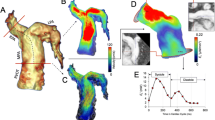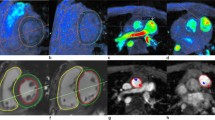Abstract
The optimal timing for pulmonary valve replacement after Tetralogy of Fallot (TOF) repair remains controversial. In this study, we estimated the feasibility of using flow energy loss (FEL) to predict right ventricular (RV) deterioration due to pulmonary regurgitation after TOF repair. We examined RV outflow tract (RVOT) flow in nine patients who underwent TOF or double-outlet right ventricle repair in the intervention group (Group I) and compared them with three healthy children in the control group (Group C). We evaluated flow across the RVOT and pulmonary valve by vector flow mapping (VFM) on echocardiography and by phase contrast-magnetic resonance imaging (PC-MRI). Next, we calculated FEL and analyzed the relationship between FEL and clinical parameters of RV function. The mean FEL was significantly greater in Group I than in Group C (p = 0.002). Flow pattern and FEL were comparable by VFM and PC-MRI at the same phase 14.6 years after TOF repair. There was a significant positive correlation for the cardiothoracic ratio with both the mean FEL [correlation coefficient (r) = 0.78; p = 0.012] and the diastolic peak FEL (r = 0.75; p = 0.021) in Group I. There was also a significant positive correlation between the serial change in QRS duration with both the mean FEL (r = 0.82; p = 0.014) and the diastolic FEL (r = 0.70; p = 0.052) in Group I. FEL by VFM is an effective tool for evaluating ventricular deterioration caused by RV workload.






Similar content being viewed by others
References
Gatzoulis MA, Balaji S, Webber SA, Siu SC, Hokanson JS, Poile C, Rosenthal M, Nakazawa M, Moller JH, Gillette PC, Webb GD, Redington AN (2000) Risk factors for arrhythmia and sudden cardiac death late after repair of Tetralogy of Fallot: a multicentre study. Lancet 356:975–981
Geva T, Sandweiss BM, Gauvreau K, Lock JE, Powell AJ (2004) Factors associated with impaired clinical status in long-term survivors of Tetralogy of Fallot repair evaluated by magnetic resonance imaging. J Am Coll Cardiol 43:1068–1074
Frigiola A, Redington AN, Cullen S, Vogel M (2004) Pulmonary regurgitation is an important determinant of right ventricular contractile dysfunction in patients with surgically repaired Tetralogy of Fallot. Circulation 110(11 Suppl 1):II153–II157
Therrien J, Provost Y, Merchant N, Williams W, Colman J, Webb G (2005) Optimal timing for pulmonary valve replacement in adults after Tetralogy of Fallot repair. Am J Cardiol 95:779–782
Henkens IR, van Straten A, Schalij MJ, Hazekamp MG, de Roos A, van der Wall EE, Vliegen HW (2007) Predicting outcome of pulmonary valve replacement in adult Tetralogy of Fallot patients. Ann Thorac Surg 83:907–911
Geva T, Gauvreau K, Powell AJ, Cecchin F, Rhodes J, Geva J, del Nido P (2010) Randomized trial of pulmonary valve replacement with and without right ventricular remodeling surgery. Circulation 122(11 Suppl):S201–S208
Itatani K, Okada T, Uejima T, Tanaka T, Ono M, Miyaji K, Takenaka K (2013) Intraventricular flow velocity vector visualization based on the continuity equation and measurements of vorticity and wall shear stress. Jpn J Appl Phys 52:07HF16
Nollert G, Fischlein T, Bouterwek S, Böhmer C, Klinner W, Reichart B (1997) Long-term survival in patients with repair of Tetralogy of Fallot: 36-year follow-up of 490 survivors of the first year after surgical repair. J Am Coll Cardiol 30:1374–1383
Warnes CA, Williams RG, Bashore TM, Child JS, Connolly HM, Dearani JA, del Nido P, Fasules JW, Graham TP Jr, Hijazi ZM, Hunt SA, King ME, Landzberg MJ, Miner PD, Radford MJ, Walsh EP, Webb GD, Smith SC Jr, Jacobs AK, Adams CD, Anderson JL, Antman EM, Buller CE, Creager MA, Ettinger SM, Halperin JL, Hunt SA, Krumholz HM, Kushner FG, Lytle BW, Nishimura RA, Page RL, Riegel B, Tarkington LG, Yancy CW, American College of Cardiology, American Heart Association Task Force on Practice Guidelines (Writing Committee to Develop Guidelines on the Management of Adults With Congenital Heart Disease), American Society of Echocardiography, Heart Rhythm Society, International Society for Adult Congenital Heart Disease, Society for Cardiovascular Angiography and Interventions, Society of Thoracic Surgeons (2008) ACC/AHA 2008 guidelines for the management of adults with congenital heart disease: a report of the American College of Cardiology/American Heart Association Task Force on Practice Guidelines (Writing Committee to Develop Guidelines on the Management of Adults with Congenital Heart Disease). Developed in Collaboration with the American Society of Echocardiography, Heart Rhythm Society, International Society for Adult Congenital Heart Disease, Society for Cardiovascular Angiography and Interventions, and Society of Thoracic Surgeons. J Am Coll Cardiol 52:e143–e263
Silversides CK, Kiess M, Beauchesne L, Bradley T, Connelly M, Niwa K, Mulder B, Webb G, Colman J, Therrien J (2010) Canadian Cardiovascular Society 2009 Consensus Conference on the management of adults with congenital heart disease: outflow tract obstruction, coarctation of the aorta, Tetralogy of Fallot, Ebstein anomaly and Marfan’s syndrome. Can J Cardiol 26:e80–e97
Baumgartner H, Bonhoeffer P, De Groot NM, de Haan F, Deanfield JE, Galie N, Gatzoulis MA, Gohlke-Baerwolf C, Kaemmerer H, Kilner P, Meijboom F, Mulder BJ, Oechslin E, Oliver JM, Serraf A, Szatmari A, Thaulow E, Vouhe PR, Walma E, Task Force on the Management of Grown-up Congenital Heart Disease of the European Society of Cardiology (ESC), Association for European Paediatric Cardiology (AEPC), ESC Committee for Practice Guidelines (CPG) (2010) ESC Guidelines for the management of grown-up congenital heart disease (new version 2010). Eur Heart J 31:2915–2957
Geva T (2006) Indications and timing of pulmonary valve replacement after Tetralogy of Fallot repair. Semin Thorac Cardiovasc Surg Pediatr Card Surg Annu 9:11–22
Davlouros PA, Kilner PJ, Hornung TS, Li W, Francis JM, Moon JC, Smith GC, Tat T, Pennell DJ, Gatzoulis MA (2002) Right ventricular function in adults with repaired tetralogy of Fallot assessed with cardiovascular magnetic resonance imaging: detrimental role of right ventricular outflow aneurysms or akinesia and adverse right-to-left ventricular interaction. J Am Coll Cardiol 40:2044–2052
Therrien J, Siu SC, McLaughlin PR, Liu PP, Williams WG, Webb GD (2000) Pulmonary valve replacement in adults late after repair of Tetralogy of Fallot: are we operating too late?. J Am Coll Cardiol 36:1670–1675
Lee C, Kim YM, Lee CH, Kwak JG, Park CS, Song JY, Shim WS, Choi EY, Lee SY, Baek JS (2012) Outcomes of pulmonary valve replacement in 170 patients with chronic pulmonary regurgitation after relief of right ventricular outflow tract obstruction: implications for optimal timing of pulmonary valve replacement. J Am Coll Cardiol 60:1005–1014
Bokma JP, Winter MM, Oosterhof T, Vliegen HW, van Dijk AP, Hazekamp MG, Koolbergen DR, Groenink M, Mulder BJ, Bouma BJ (2016) Preoperative thresholds for mid-to-late haemodynamic and clinical outcomes after pulmonary valve replacement in tetralogy of Fallot. Eur Heart J 37:829–835
Harrild DM, Berul CI, Cecchin F, Geva T, Gauvreau K, Pigula F, Walsh EP (2009) Pulmonary valve replacement in tetralogy of Fallot: impact on survival and ventricular tachycardia. Circulation 119:445–451
Itatani K, Miyaji K, Qian Y, Liu JL, Miyakoshi T, Murakami A, Ono M, Umezu M (2012) Influence of surgical arch reconstruction methods on single ventricle workload in the Norwood procedure. J Thorac Cardiovasc Surg 144:130–138
Itatani K (2014) When the blood flow becomes bright. Eur Heart J 35:747–752a
Honda T, Itatani K, Takanashi M, Mineo E, Kitagawa A, Ando H, Kimura S, Nakahata Y, Oka N, Miyaji K, Ishii M (2014) Quantitative evaluation of hemodynamics in the Fontan circulation: a cross-sectional study measuring energy loss in vivo. Pediatr Cardiol 35:361–367
Nakashima K, Itatani K, Kitamura T, Oka N, Horai T, Miyazaki S, Nie M, Miyaji K (2017) Energy dynamics of the intraventricular vortex after mitral valve surgery. Heart Vessels 32:1123–1129. https://doi.org/10.1007/s00380-017-0967-6
Hayashi T, Itatani K, Inuzuka R, Shimizu N, Shindo T, Hirata Y, Miyaji K (2015) Dissipative energy loss within the left ventricle detected by vector flow mapping in children: normal values and effects of age and heart rate. J Cardiol 66:403–410
Kakizaki R, Nabeta T, Ishii S, Koitabashi T, Itatani K, Inomata T, Ako J (2016) Cardiac resynchronization therapy reduces left ventricular energy loss. Int J Cardiol 221:546–548
Nabeta T, Itatani K, Miyaji K, Ako J (2015) Vortex flow energy loss reflects therapeutic effect in dilated cardiomyopathy. Eur Heart J 36:637
Honda T, Itatani K, Miyaji K, Ishii M (2014) Assessment of the vortex flow in the post-stenotic dilatation above the pulmonary valve stenosis in an infant using echocardiography vector flow mapping. Eur Heart J 35:306
Garcia D, Pibarot P, Dumesnil JG, Sakr F, Durand LG (2000) Assessment of aortic valve stenosis severity: a new index based on the energy loss concept. Circulation 101:765–771
Bahlmann E, Gerdts E, Cramariuc D, Gohlke-Baerwolf C, Nienaber CA, Wachtell K, Seifert R, Chambers JB, Kuck KH, Ray S (2013) Prognostic value of energy loss index in asymptomatic aortic stenosis. Circulation 127:1149–1156
Stugaard M, Koriyama H, Katsuki K, Masuda K, Asanuma T, Takeda Y, Sakata Y, Itatani K, Nakatani S (2015) Energy loss in the left ventricle obtained by vector flow mapping as a new quantitative measure of severity of aortic regurgitation: a combined experimental and clinical study. Eur Heart J Cardiovasc Imaging 16:723–730
Nogami Y, Ishizu T, Atsumi A, Yamamoto M, Kawamura R, Seo Y, Aonuma K (2013) Abnormal early diastolic intraventricular flow ‘kinetic energy index’ assessed by vector flow mapping in patients with elevated filling pressure. Eur Heart J Cardiovasc Imaging 14:253–260
Mulla N, Simpson P, Sullivan NM, Paridon SM (1997) Determinants of aerobic capacity during exercise following complete repair of tetralogy of Fallot with a transannular patch. Pediatr Cardiol 18:350–356
Kirklin JK, Kirklin JW, Blackstone EH, Milano A, Pacifico AD (1989) Effect of transannular patching on outcome after repair of tetralogy of Fallot. Ann Thorac Surg 48:783–791
Yoo BW, Kim JO, Kim YJ, Choi JY, Park HK, Park YH, Sul JH (2012) Impact of pressure load caused by right ventricular outflow tract obstruction on right ventricular volume overload in patients with repaired tetralogy of Fallot. J Thorac Cardiovasc Surg 143:1299–1304
Author information
Authors and Affiliations
Corresponding author
Ethics declarations
Conflict of interest
The authors declare that they have no conflict of interest with respect to this manuscript.
Informed Consent
Informed consent was obtained from all individual participants included in this study.
Rights and permissions
About this article
Cite this article
Shibata, M., Itatani, K., Hayashi, T. et al. Flow Energy Loss as a Predictive Parameter for Right Ventricular Deterioration Caused by Pulmonary Regurgitation After Tetralogy of Fallot Repair. Pediatr Cardiol 39, 731–742 (2018). https://doi.org/10.1007/s00246-018-1813-z
Received:
Accepted:
Published:
Issue Date:
DOI: https://doi.org/10.1007/s00246-018-1813-z




